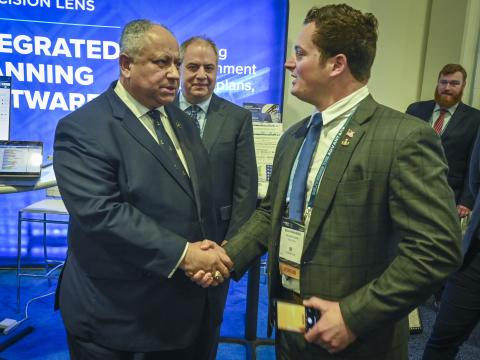Emergency Communications Plan Sets Spending Priorities
The U.S. Department of Homeland Security’s (DHS’s) Office of Emergency Communications (OEC) has developed the nation’s first National Emergency Communications Plan (NECP). The plan will be the center for future decisions concerning grant awards from the department. It outlines steps that will be taken at the federal, state and local levels to ensure communications across all disciplines as needed, on demand and as authorized. The NECP aims to address the gaps in capabilities identified by events such as the terrorist attacks of September 11, 2001, and Hurricane Katrina.
Developed with input from all 56 states and
To meet these goals, the NECP established seven objectives for improving emergency communications. It calls for formal decision-making structures and defined leadership roles to coordinate emergency communications capabilities. Federal programs and initiatives should be collaborative across agencies. It states that emergency responders employ common planning and operational protocols to use their resources and personnel effectively. Emerging technologies are to be integrated with existing capabilities by implementing standards as well as research, development, testing and evaluation. Also called for are common approaches to training and exercises involving emergency responders to improve technical expertise and to enhance response capabilities. Long-term strategic planning at all levels of government should involve integrated planning procedures, appropriate resource allocations and public-private partnerships. The final strategic objective is ensuring that the
The NECP does not only apply to the technology continuity of the communications involved. The plan directs measurable and sustainable improvements that are consistent with several initiatives already in place, including the National Response Framework, the National Incident Management System, National Preparedness Guidelines and the Target Capabilities List. 
The plan is the result of a congressional directive. Title XVIII of the Homeland Security Act of 2002 required that the OEC create short- and long-term guidance to address national emergency communications deficiencies; provisions under the Fiscal Year 2007 DHS Appropriations Act supported this requirement. However, more than just government agency personnel were involved in designing the NECP; private sector emergency communications officials also contributed to the final product.
According to Amy Cudwa, DHS spokesperson, the plan is designed to address the issue of emergency communications from an overall national perspective rather than from the top down. During the first year of the NECP’s implementation, the DHS will partner with key stakeholders, including industry, to determine what metrics should be used to measure progress. This will ensure that federal, state, local and tribal organizations are assessed by the same standards, Cudwa says.
She relates that achieving the NECP’s goals and objectives will be the focus of grant awards, easing the strain on local budgets. As actions compatible with the plan proceed and are based on metrics, the department will be able to reassess to determine where funding is needed most, Cudwa adds. “As we look at the metrics, we will know more specifically what to do. We will know what to fund in terms of the grant program,” she says. More than $2.5 billion already has been dispersed through the Interoperable Emergency Communications Grant program, and more than $1 billion is still available, she relates.
In terms of technology, the DHS is interested in interoperable radios, but Cudwa explains that it also will be paying attention to research and development in a range of technologies. “Research and development is where industry comes in,” she says, “because they can give us guidance.” Scalability will be important since solutions must be practical for use by small as well as large organizations and jurisdictions, she adds.
“The NECP ensures that communications isn’t the hold-up to responding to an event,” Cudwa states.



